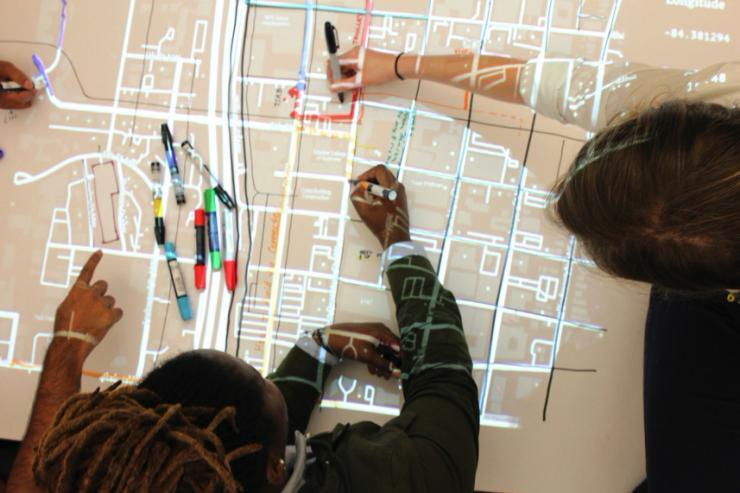Building Community Resilience to Intersecting Disasters
Oct 18, 2021 — Atlanta, GA

Civic Innovation Challenge - Mapping
A Georgia Tech and Savannah State University project focused on building community resilience to intersecting disasters situated in the City of Savannah has earned a $1 million grant award from the National Science Foundation (NSF) Civic Innovation Challenge (CIC). This project is a collaboration of NSF, Department of Energy Vehicle Technology Office, Department of Homeland Security Science and Technology Directorate, Federal Emergency Management Agency, and the MetroLab Network. Civic partners participating with the project include the City of Savannah, the Savannah Chatham County Public School System, and the Harambee House.
Allen Hyde, assistant professor in the School of History and Sociology at the Georgia Institute of Technology, is the principal investigator (PI) for the project. He is working closely with Co-principal investigators on this project including Nisha Botchwey, associate Dean of Academic Programs at Georgia Tech and professor of City and Regional Planning; Yanni Loukissas, associate professor of digital media in the School of Literature, Media, and Communication at Georgia Tech; Mildred McClain, Ph.D., executive director of the Harambee House; and Philip Omunga, assistant professor in the department of Political Science and Public Affairs at Savannah State University.
The research is entitled, “Visualizing Resilience: BIPOC Youth Advocacy through Mapmaking.” BIPOC refers to Black, Indigenous, and People of Color. The project seeks to address intersecting disasters which include natural disasters like hurricanes and flooding, but also industrial pollution, the pandemic, and systemic racism in coastal communities of color. The city and surrounding areas were subject to four hurricanes and three mandatory evacuations from 2016-2019.
“I hope to see youth become better advocates for disaster resilience in their community. Maybe this becomes a career path for them, and they become leaders in the future,” said Hyde. “I also want to see the city and local governments and partners become energized around disaster preparedness. I think 2020-2021 has been a wakeup call for disasters of all types from hurricanes to flooding to wildfires to drought to COVID-19. This is the current reality, and we need to better prepare and become more resilient.”
This project will engage BIPOC youth living within frontline, Savannah-area coastal communities in disaster resilience planning through mapmaking and advocacy. Map Spot, a creative and accessible mapmaking tool, as well Youth Advocacy for Resilience to Disasters (YARDs), a curriculum adapted from a validated program, will be introduced to educate and empower middle-school age participants to advocate for infrastructural improvements in their neighborhoods related to disasters and their effects.
The mapmaking tool and tailored curriculum will guide middle-school aged participants enrolled in after-school clubs to map the effects of intersecting disasters in their communities and identify infrastructural improvement projects to address them, and advocate for themselves and their neighbors by presenting their maps to community leaders, local experts, and public officials.
The project will also contribute to research in three different areas: 1) It will strengthen disaster resilience scholarship by illuminating how BIPOC youth, a vulnerable yet relatively understudied group, can promote resilience in their communities; 2) It will introduce and evaluate a tool as well as a paired curriculum for digital civics, which can help BIPOC youth do the work of resilience planning. 3) It will benefit scholarship on youth advocacy by demonstrating its relationship to self-efficacy, collective efficacy, and broadening community networks.
Research has shown that engaging youth in advocacy and disaster preparedness can substantially enhance disaster resilience. The project and its Visualizing Resilience framework will engage with coastal communities on the west side of Savannah, Georgia, where the project team already has significant experience in disaster-related data collection, community engagement, and resilience planning. Following the pilot, the Visualizing Resilience framework they will use will be transferred to other communities at risk of disasters in Georgia and across the United States.
"During Stage 1 of the NSF Civic Innovation Challenge that included work with Metrolab, we did additional community engagement with the Harambee House and City of Savannah's Office of Sustainability, as well as a deep dive into data and the history of communities on the west side of Savannah,” said Hyde. “We realized that youth were a large and vulnerable population in many of these communities, and we also believe that youth are an excellent group to engage as they open doorways into families that may be busy with work and other activities, but more importantly they are the future.”
“We especially hope to see these youth learn from our YARDS curricula and become advocates for disaster resilience in their community and advocate for local level infrastructure changes to local leaders. We hope that this helps cultivate a new generation of leaders that is empowered to make positive social change in their community and prepare for a future that is resilient to the many disasters that threaten coastal communities in the 21st century."
Walter Rich




